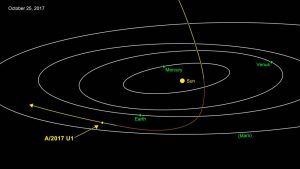
Since mid-October, the astronomy community has been buzzing about what might be our Solar System’s first confirmed interstellar visitor. An automated telescope spotted an object that appeared as if it had been dropped on the Solar System from above, an angle that suggests it arrived from elsewhere. Now, a team of astronomers has rushed out a paper that describes the object's odd properties and gives it the name “1I/2017 U1 ‘Oumuamua.” In Hawaiian, ‘Oumuamua roughly means “first messenger,” and the 1I indicates that it’s the first interstellar object.
‘Oumuamua was first spotted on October 19 by the Pan-STARRS1 automated telescope system. Pan-STARRS1 turned out to have captured images of the object the day previously, but the automated analysis software hadn’t identified it. Further images over the next few days allowed researchers to refine its travel through our Solar System, confirming that ‘Oumuamua was making the most extreme approach toward the inner Solar System of any object we’ve ever seen. In essence, it appeared to have been dropped onto the Solar System from above, plunging between the Sun and the orbit of Mercury. It was also moving extremely quickly.
The Solar System was formed from a flattened disk of material, and all of the planets orbit roughly in the plane of that disk. Smaller objects, like dwarf planets and comets, may take somewhat more erratic approaches with orbits tilted out of that plane, but they still roughly aligned with it. We had literally never seen anything like ‘Oumuamua.

Comets tend to have the most extreme orbits, but imaging revealed that, despite its close approach to the Sun, ‘Oumuamua did not vent any dust or particles as it heated up. Within the limits of our detection, there was 10 million times less matter than you’d expect to see vented by a comet. So, ‘Oumuamua appears to be more of an asteroid. Its reddish tinge is typical of objects with a lot of organic chemicals on their surface.
Further hints as to its composition come from its odd shape and rotation. Over a 7.3-hour period, the amount of light ‘Oumuamua reflects changes by a factor of over 2.5. Either parts of its surface differ radically in terms of how much light it reflects, or the object has an oblong shape. The authors suggest it is cigar-shaped (technically a “triaxial ellipsoid”), with two of its axes approximately 80 meters across and the third about 800 meters. If that’s the case, then it has to be fairly solid to hold up to the stress of its rapid rotation.
The authors of the paper can’t rule out that ‘Oumuamua started out at the outer edges of our Solar System but got thrown inward at an odd angle by interactions with an unknown planet. But this would require the existence of a rather large planet at a great distance from the Sun, so they consider that unlikely.
In addition, models of Solar System formation suggest that large planets can hurl huge amounts of small objects out into interstellar space, so it’s not surprising that we’ve finally spotted one of them. One oddity here, however, is that ‘Oumuamua looks nothing like any known objects in our Solar System. In addition, we’d expect most of the objects hurled out to be comet-like, which ‘Oumuamua clearly isn’t. So, while it’s dangerous to make too much out of a single example, it’s somewhat surprising how different from our expectations this visitor is.
While there is a recently formed exosolar system in roughly the direction that ‘Oumuamua came from, it wasn’t in that location back when ‘Oumuamua would have been ejected on its current path. So we don’t really know where it came from.
Its close approach to the Sun has curved ‘Oumuamua into a somewhat parabolic orbit. After dropping below the plane of the Solar System, the object has shot back above the plane somewhere between the orbits of Earth and Mars. It’s now rapidly moving away from all our telescopes and will fade out of view rather quickly.
But researchers expect that we’ll have other visitors from outside our Solar System. ‘Oumuamua was discovered shortly after Pan-STARRS1 had a software upgrade in its analysis pipeline that was intended to help it identify more objects that would otherwise be rejected as spurious signals. If ‘Oumuamua is an indication that the software worked, then we might have additional discoveries sooner rather than later.
Nature, 2017. DOI: 10.1038/nature25020 (About DOIs).
reader comments
262